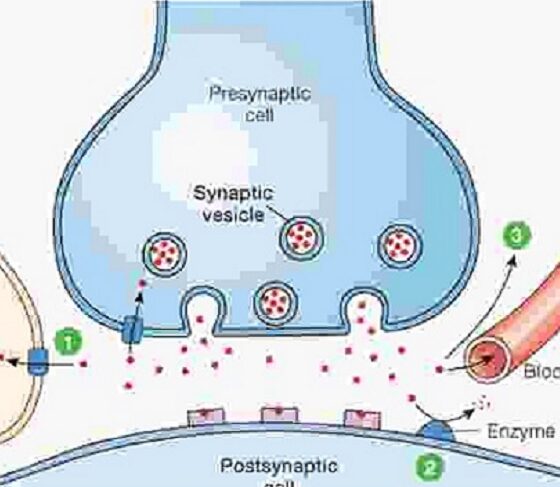Two neurons do not directly touch each other, there is a slight gap between the terminal buttons of sending neuron and the dendrites of receiving neuron. This gap is called a synapse and the gap is called the synaptic gap. The signal must travel the synaptic gap.
When there is the action potential, it moves down and arrives at terminal buttons. At terminal buttons tiny small packet called synaptic vesicles contains neurotransmitters. When an action potential travels and reaches to vesicles stimulation tend to release neurotransmitter in the synaptic gap.

The neuron from which neurotransmitter is released called the presynaptic neuron. There are receptors in postsynaptic neurons from where this neurotransmitter binds with respective receptors. The effect of neurotransmitter is sometimes excitatory (generate action potential) and sometimes inhibitory (less likely to generate action potential).
Some of the important neurotransmitter :
Neurotransmitters are divided according to their molecular structure into amino acids, peptides, monoamines, and others.
1. Norepinephrine: Norepinephrine is also called noradrenaline and affects our arousal, alertness. In the fight or flight response of the body, norepinephrine plays a vital role in regulating heart rate and blood pressure.
Norepinephrine mainly produced at the brain stem. The level of Norepinephrine affects a person’s mood level. Norepinephrine is released by autonomic neurons in the PNS (peripheral nervous system).
2. Glutamate: Glutamate is an excitatory neurotransmitter found in the central nervous system. It belongs to the amino acid family group and fast-acting neurotransmitters.
It is the most common excitatory neurotransmitter of the nervous system because most of the time in the nervous system when a neuron is releasing a neurotransmitter that’s exciting its target cell most of the time that neurotransmitter because it usually causes depolarization of the target cells so that it excites them.
3. GABA: GABA is the most common inhibitory neurotransmitter in the brain while glycine is the most common inhibitory neurotransmitter in the spinal cord so that the amino acid neurotransmitters are involved in many functions of both nervous system (CNS and PNS).
Muscle movements cannot be controlled by the brain without GABA. GABA is a major inhibitory neurotransmitter in the brain, anti-anxiety drugs enhance the activity of GABA.
4. Acetylcholine: It does a number of functions in the central nervous system, and then in the peripheral nervous system. It’s released by most neurons in the autonomic nervous system and it’s released by neurons called motor neurons that synapse on skeletal muscle and tell our skeletal muscle to contract to make us move.
It is excitatory and found in the forebrain. Acetylcholine tends to degenerate in Alzheimer’s patients. Less Acetylcholine more the memory loss.
5. Dopamine : Dopamine involved in motivation and emotional pleasure. Too much dopamine may cause schizophrenia and too little lead to Parkinson’s disease. Dopamine mediates the natural rewards of the human body like food, sex.
6. Serotonin: Serotonin involved in mood regulation. Drugs that increase the level of serotonin alleviate symptoms of depression and anxiety. The lower level of serotonin has been associated with feelings of depression and anxiety.
Serotonin is also important in regulating sleep and appetite. It belongs to a family of small-molecule neurotransmitters. Serotonin neurotransmitters may be useful in fighting obesity in humans.
Credits:istockphoto,shutterstock

